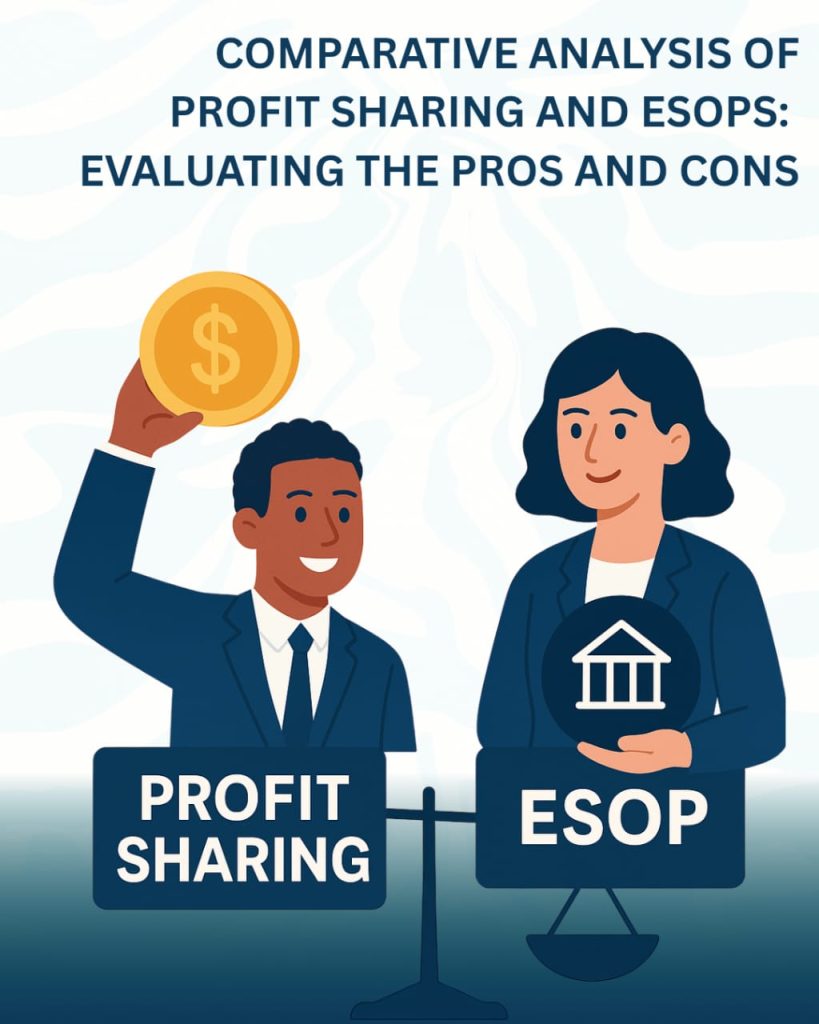Getting employees invested in a company’s success isn’t just good for morale—it’s good for business. After all, when a company thrives, the people who helped make that happen deserve to share in the rewards.
That’s where Profit Sharing and Employee Stock Ownership Plans (ESOPs) come in. Both are powerful tools to align employee interests with the company’s goals, but they work in very different ways.
Imagine working at a startup that’s just had a record-breaking year. Revenues are up, and it’s clear that everyone’s hard work has paid off. In a profit-sharing model, the company might decide to distribute a portion of those profits among employees. Think of it like a bonus: simple, direct, and timely. Your contribution led to success, and you’re rewarded almost immediately.
Now, picture a different scenario. Instead of receiving a bonus, you’re granted shares in the company through an ESOP. These shares vest over time. As the company grows in value, so does your stake. The reward isn’t instant, but it can be significantly more valuable in the long run. It’s not just a job—you’re building wealth and becoming a part-owner of the business.
Both approaches aim to keep employees motivated, but they work differently:
- Profit Sharing is great for short-term motivation and celebrating immediate wins.
- ESOPs encourage employees to think long-term and contribute to the company’s sustained growth.
Which one is better?
It depends on your company’s culture and what you want to prioritise! quick rewards or long-term investment. Both can be valuable tools to show your team that their hard work truly matters. Let’s understand their pros and cons to help you decide which approach might work best for your business.
Pros and Cons of Profit Sharing
In comparison to ESOPs, profit-sharing systems have several advantages.
First, linking pay to performance is likely to make employees more motivated and productive. Particularly when there are no restrictions on pay levels or income growth for high-performing employees, a profit-sharing system can strongly encourage everyone to contribute more towards improving the company’s performance.
Second, profit sharing tends to create a sense of ownership among employees, as they receive a share of the company’s profits. This shared ownership perspective can help employees better understand management’s goals and align their efforts with the company’s long-term vision.
Third, when extended to the entire workforce, profit sharing can help companies build a loyal, skilled, and high-performing team. It also fosters a team-oriented atmosphere, encouraging collaboration and reducing internal conflicts. Profit sharing has been particularly popular in the tax-exempt sector.
Nonetheless, profit sharing also has several drawbacks.
First, not all employees benefit equally from profit-sharing systems, especially those based on group performance. Disparities in distribution can arise, and many employees are unaware of how their company’s profit-sharing plan works.
Second, since profit-sharing rewards are typically calculated in proportion to salary, hourly workers who usually earn lower wages tend to receive smaller profit shares. As a result, these employees often receive a smaller portion of their total compensation through profit sharing compared to salaried employees.
Third, a significant disadvantage of profit sharing is that it can encourage a short-term focus, especially when performance is measured mainly by profitability. This may lead employees to prioritise immediate financial results over long-term objectives, potentially neglecting important aspects such as customer service, product quality, and innovation, which are not directly reflected in profit margins.
Pros and Cons of ESOPs
ESOPs offer several benefits to both companies and employees. They help boost employee motivation and retention by giving team members a sense of ownership. When employees hold a stake in the company, they’re more likely to work toward its long-term success.
ESOPs can also serve as a powerful tool for wealth creation. As the company grows in value, so do the employees’ shares helping them build long-term financial security. Additionally, ESOPs align employee interests with the company’s performance and are often used by founders as part of succession planning.
That said, ESOPs are not without their challenges, and it’s important to weigh the potential downsides before implementation.
Implementing an ESOP requires professional expertise for its design, implementation, and compliance with legal regulations, including the Companies Act, 2013, and SEBI regulations for listed companies. This process can be complex and expensive, particularly for small and medium-sized enterprises (SMEs). Each stage demands careful planning and expert guidance.
Organisations with limited working capital or existing financial constraints may find it challenging to introduce an ESOP. Moreover, the requirement to buy back shares when employees exit the company can create significant liquidity issues. This is especially relevant in India, where many companies may lack the financial reserves to handle such obligations.
Finally, distributing equity among employees can sometimes lead to imbalances in the benefits structure, especially in privately held companies where shares are not transferable without Board approval. Employees may face difficulties in realising the value of their shares due to the limited liquidity of such holdings in the Indian market.
Conclusion
Both profit-sharing plans and ESOPs offer advantages that organisations aiming to promote shared ownership should consider. Before implementing either of these compensation systems, it is essential to conduct a careful and thorough analysis of the organisation’s specific objectives and goals. Only after this assessment can the organisation determine the most suitable approach and effectively educate employees about their stake in the company.
Moreover, creating a culture of shared ownership through open communication is important. This culture should not remain static; it needs to be reviewed from time to time to keep up with changes in the business environment.
Curious about whether Profit Sharing or ESOPs is the better fit for your company’s goals and culture? Book a call with us using the link below for expert insights and tailored recommendations!


